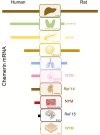Chemerin as a Driver of Hypertension: A Consideration
- PMID: 32453820
- PMCID: PMC7759724
- DOI: 10.1093/ajh/hpaa084
Chemerin as a Driver of Hypertension: A Consideration
Abstract
The protein chemerin (tazarotene-induced gene, TIG2; RARRES2) is a relatively new adipokine. Many studies support that circulating chemerin levels associate strongly and positively with body mass index, visceral fat, and blood pressure. Here, we focus on the specific relationship of chemerin and blood pressure with the goal of understanding whether and how chemerin drives (pathological) changes in blood pressure such that it could be interfered with therapeutically. We dissect the biosynthesis of chemerin and how current antihypertensive medications change chemerin metabolism. This is followed with a review of what is known about where chemerin is synthesized in the body and what chemerin and its receptors can do to the physiological function of organs important to blood pressure determination (e.g., brain, heart, kidneys, blood vessels, adrenal, and sympathetic nervous system). We synthesize from the literature our best understanding of the mechanisms by which chemerin modifies blood pressure, with knowledge that plasma/serum levels of chemerin may be limited in their pathological relevance. This review reveals several gaps in our knowledge of chemerin biology that could be filled by the collective work of protein chemists, biologists, pharmacologists, and clinicians.
Keywords: blood pressure; chemerin; hypertension; obesity.
© The Author(s) 2020. Published by Oxford University Press on behalf of American Journal of Hypertension, Ltd.
Figures







References
-
- Wittamer V, Franssen JD, Vulcano M, Mirjolet JF, Le Poul E, Migeotte I, Brézillon S, Tyldesley R, Blanpain C, Detheux M, Mantovani A, Sozzani S, Vassart G, Parmentier M, Communi D. Specific recruitment of antigen-presenting cells by chemerin, a novel processed ligand from human inflammatory fluids. J Exp Med 2003; 198:977–985. - PMC - PubMed
-
- Wittamer V, Bondue B, Guillabert A, Vassart G, Parmentier M, Communi D. Neutrophil-mediated maturation of chemerin: a link between innate and adaptive immunity. J Immunol 2005; 175:487–493. - PubMed
-
- Hart R, Greaves DR. Chemerin contributes to inflammation by promoting macrophage adhesion to VCAM-1 and fibronectin through clustering of VLA-4 and VLA-5. J Immunol 2010; 185:3728–3739. - PubMed
Publication types
MeSH terms
Substances
Grants and funding
LinkOut - more resources
Full Text Sources
Medical
Miscellaneous

